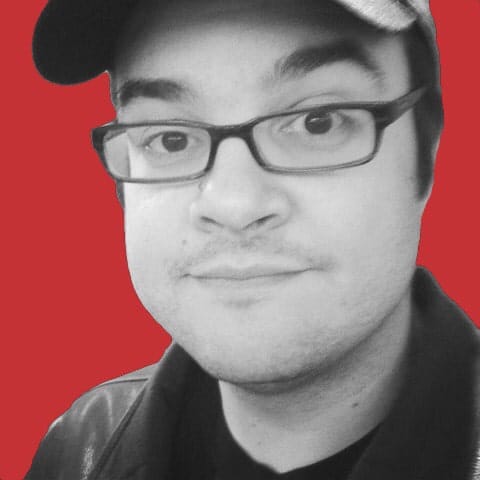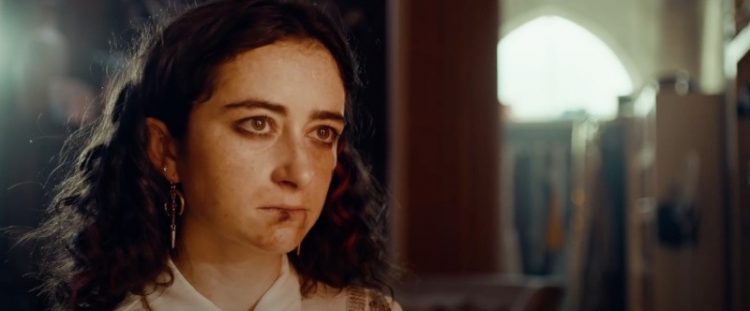We chat with the director about her one-of-a-kind country music horror film and how it exposes an anxiety surrounding a slowly evolving creative industry.
Paramount
By Brad Gullickson · Published on June 12th, 2022
Check the Gate is a recurring column where we go one-on-one with directors in an effort to uncover the reasoning behind their creative decisions. Why that subject? Why that shot? In this edition, we chat with Brea Grant about Torn Hearts, the one-of-a-kind country music horror flick.
Humans are at their deadliest when they’re either trapped or on the verge of success. We’ll do pretty much anything to survive, and we’ll absolutely do anything when we’re inches away from achieving a childhood dream. When the fantasy feels years away, we’re cool and determined. When the fantasy appears minutes from manifesting into a reality, we’re twitchy, vicious little beasts.
Torn Hearts is a nasty, heated, and honest horror set within the Nashville music scene. Alexxis Lemire and Abby Quinn play a country duo struggling to make their mark on the town. Each gig gets them closer, but their recent victories quickly crumble into failures. When they locate Katey Sagal, an icon on many fronts, the duo hopes to absorb her mojo and use it to solidify their career.
After directing two features she’d also scripted (Best Friends Forever, 12 Hour Shift), Brea Grant latched onto Torn Hearts. Written by Rachel Koller Croft, the film digs into numerous creative insecurities, using those squishy emotions to propel its characters and audience into a savage confrontation. Three women are locked in a house, each one carrying a secret, each one carrying a desire. Torn Hearts is brutally entertaining, relying heavily on its all-too-capable performers, and allows Grant to exorcise a few demons.
“It was less about the competition,” says Grant, “and more about the way these industries pit us against each other, whether or not we mean to fall into that trap. I fall into that trap all the time. I have very successful friends. I’ve dated very successful people who are doing far better than me. And yeah, there’s definitely a part of me that starts to feel jealousy, but also a part of me that finds motivation in that, that pushes me along a little bit.”
Brea responded passionately to Croft’s script, appreciating how the narrative steered away from judgment and presented empathy for how each character landed in their roles. There is a system that hangs over Torn Hearts‘ horrors, an antagonistic force that smashes these three women into violent conflict. Grant never wanted to lose sight of the enemy.
“When I was reading the script,” she continues, “it was more about these three women, who were coming at it from three different points of view. They’d all been taught something different – that would get them to be able to become the artist they wanted to be. For me, it was about showing the way in which some of them had bought into the system, how some were trying to go around the system, and how they were trying to figure it out. But at the end of the day, they’re all screwed because it’s not a nice system.”
Grant delighted in immersing herself in Croft’s screenplay. Jumping away from something that did not originate from her pen proved no different than any other project. She simply fell into her previous day job.
“What’s interesting about my career,” says Grant, “is that I started as an actor. So, I’m really used to taking other people’s material and interpreting it and making it my own. I think that’s one of my strongest skillsets because I acted for so many years. That’s all you do as an actor; you take other people’s words, try to make them believable, or try to sell them and get across the point that they’re trying to make.”
Every movie is a team-up. They’re not novels. They’re not comic books. Hundreds of hands come together on a set, and the film is the result of that entangled gathering.
“It was about reading Rachel’s script,” continues Grant, “thinking about what she was trying to do and thinking about how I could make it personal for myself and do some things that I was really looking forward to doing. I think it’s just about collaboration. I’ve gotten really fortunate in the last couple of years.”
Grant didn’t have a lot of prep time on Torn Hearts. By the time she pitched her take to Blumhouse and signed onto the movie, the director got less than four weeks to assemble and strengthen her perspective.
“I found the easiest way was to make a big document with all of my influences,” says Grant. “It had all my inspirations, what I felt like the themes were and how we could express that in the visual language. Whether it was through costumes, whether it’s through little things, or knickknacks you see around the house. It was great because the system that they have going for these movies is that it’s the same crew, but they trade out the director and the DP every time. This crew had already done four of these movies, but I handed them this thing, and I was like, ‘This is my movie. This is what this movie will look like.’ They were super on board for that and brought their own thing to it.”
Torn Hearts commands its audience to open their eyes and prick up their ears. As tensions rise and violence inserts itself as a possible solution for those within the country icon’s mansion, we should be fully aware of the invisible hand guiding the events. From the very beginning, inside Grant’s totemic lookbook, a concern emerges.
“The commodification of the female body is a theme,” says Grant. “It’s just something you think about when you think about putting women on stage, putting women on screen. And so, I thought, one of the ways we could express that was not only through these body parts, that were already in the script – spoiler – there’s some loose body parts in this household, which Rachel wrote in, but also by putting the female form within the house. There are a lot of mannequins. There’s a lot of jewelry. There’s a loose tiara as well as just pictures of women all over the household. I felt they would express this idea of the female body throughout the film, so you never were not thinking about showing women in an ideal way.”
Brea Gant expresses hesitation regarding an audience’s willingness to join her with Torn Hearts. The system has barely widened its path, allowing new voices to pop through. There’s excitement in the possibilities and the hunger for original perspectives, but a weariness. The path can close a whole lot quicker than it opened.
“It’s such an interesting time to be a woman making art right now in these various industries,” says Grant. “There are women who have had to come up through the industry when it was a place where we were not even acknowledging that women should have a voice, and now we’re pushing female voices.”
Depending on the year a creator entered the field, their perspective is radically different. Each woman crafting Torn Hearts brought a unique philosophy and interpretation to the screenplay. The film is a result of their communion.
“It’s fascinating to see the different ways in which three years or five years can make a difference on how you see the industry,” she continues. “People who are five years younger than me look at it completely differently than the way women look at it who are five years older than me. That ten-year gap is such a huge one. I think about women like [Katey Segal’s] Harper and the things they had to do to fucking stay in the industry, the abuse they had to put up with, the things that were normalized. People ten years younger, fifteen years younger than her would never have to – well, they’re still dealing with it but wouldn’t have to deal with it in the same way. They’ve basically said this is not normal. And we’ve really done that in the last five years, which is horrifying.”
The trilogy of characters who square off against each other in Torn Hearts are doing so fueled by their director’s anxiety. Their conflict cuts into an impossibly tumultuous creative industry. Percolating underneath Torn Hearts’ three-way confrontation rests such tremendous hope, fear, excitement, and possibility. The three protagonists are on the verge of achieving something new, and that potential stirs desperation and anger.
“These generations of women have experienced sexism within the industry,” says Grant. “Watching it change and the way they interpret that for themselves and how they are supposed to be involved with it at this point, I think it’s so murky. And I think it’s hard. I wanted to push these gray areas.”
Torn Hearts offers little answers. We have to find those for ourselves. Brea Grant, however, captures the unease that comes with a cultural shift that may or may not happen. Through her exploration, we can navigate our own.
Oh, and Torn Hearts is also just a gnarly smash, satisfying those grotesque genre desires horror hounds exude, wrapped in a country music landscape. Something you’ve probably never seen before.
Torn Hearts is now available on Digital/VOD.
Related Topics: Check the Gate, directors

Brad Gullickson is a Weekly Columnist for Film School Rejects and Senior Curator for One Perfect Shot. When not rambling about movies here, he’s rambling about comics as the co-host of Comic Book Couples Counseling. Hunt him down on Twitter: @MouthDork. (He/Him)
Recommended Reading
Source by filmschoolrejects.com

